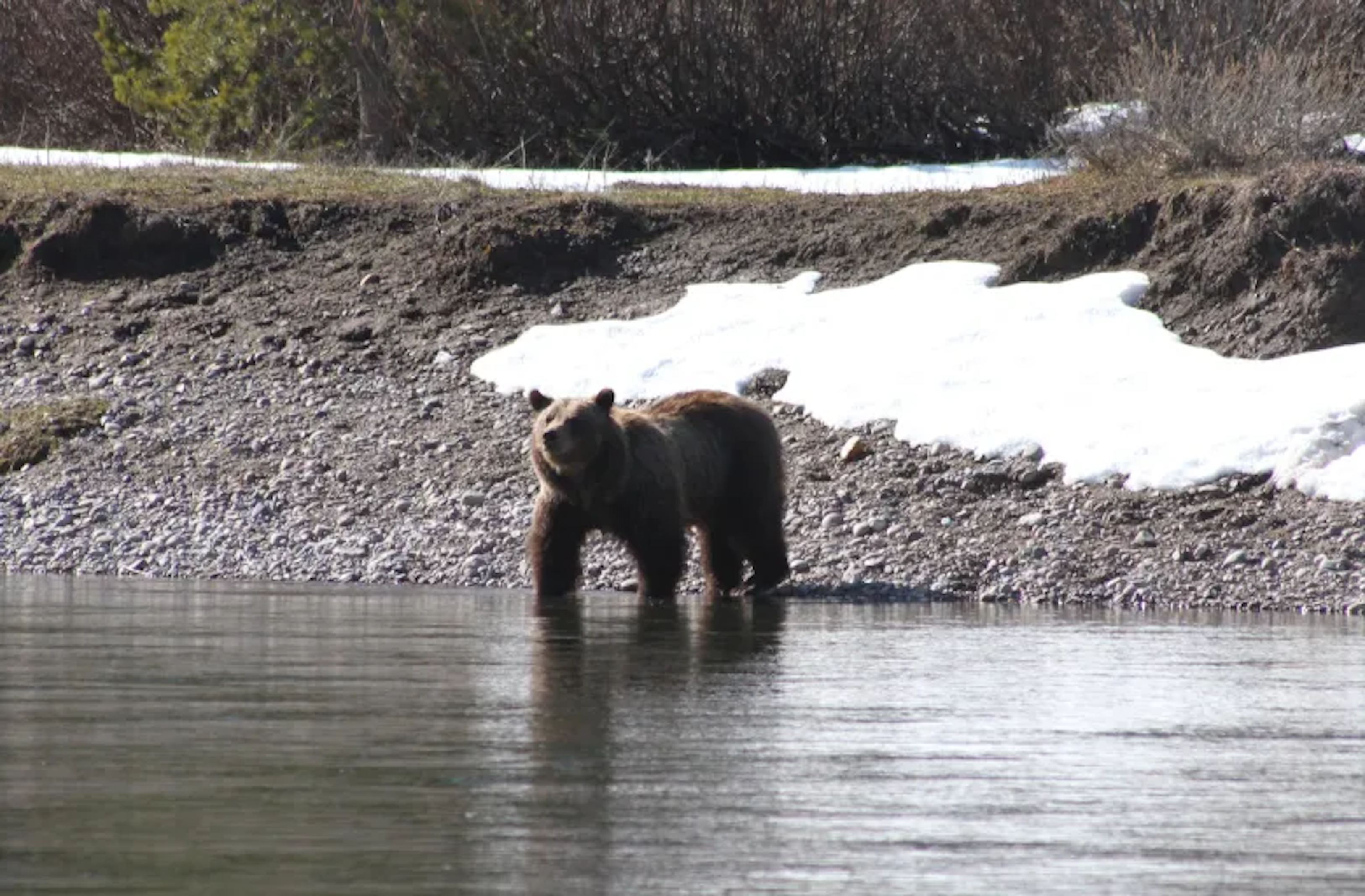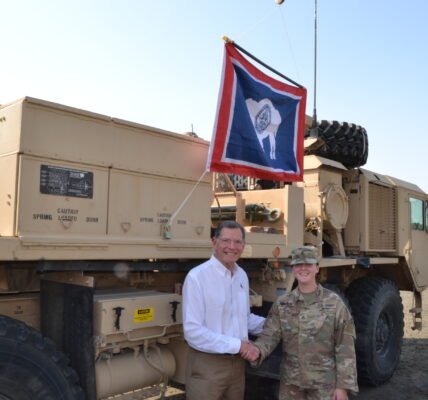
By Mike Koshmrl, WyoFile.com
Future Wyoming grizzly bear hunts — a near certainty if federal authorities approve the state’s petition to again remove the animals’ Endangered Species Act protections — would likely target more than triple the number of bruins than previously proposed hunts, according to a state analysis.
The explosion in anticipated grizzly hunting tags owes to a spike in the bear population — at least on paper.
A handover of jurisdiction from the U.S. Fish and Wildlife Service to Wyoming, Montana and Idaho is not guaranteed, but population data presented in Wyoming’s petition and publicly available federal reports paint a picture of what a grizzly bear hunt could look like.
Using the latest population numbers, from 2021, a hypothetical state-managed grizzly hunt could kill up to 10 females and 29 males in Wyoming’s portion of the tightly managed “demographic monitoring area,” according to Dan Thompson, who leads the large carnivore section of the Wyoming Game and Fish Department.
“That’s an example, based on previous estimates,” Thompson said. “Basically what we’re looking at is an increase in what’s available for harvest and what’s available as far as management flexibility with a more accurate estimate of the population.”
A change in the method of counting grizzlies in the Greater Yellowstone Ecosystem underlies that new population estimate and the resulting change in potential hunting opportunity.
In 2018, during the last era of Wyoming grizzly bear management, the grizzly population was estimated at 714 bears and the state capped its hunt at one female bear and 10 males within the DMA. (Originally Wyoming proposed targeting two female bears, though it was trimmed to one due to an interstate spat about the divvying of grizzly mortality.)
Today, however, managers estimate a population of 1,069 animals, a count biologists say is more accurate, due to an adjustment to how many female grizzlies with cubs are tallied.
Historically, sows and cubs counted aerially within 19 miles of each other were only counted once to avoid double-counting bears. An analysis found this buffer too broad. Since 2021, only sows with cubs detected within 10 miles of each other are excluded to avoid duplication.
The change in how grizzlies are counted, a process known as recalibration, was among the issues U.S. District Court Judge Dana Christensen cited when he rejected the Fish and Wildlife Service’s most recent attempt at grizzly delisting. The worry was that revising the estimate upward without simultaneously adjusting population objectives upward could result in heavy hunting and a smaller number of bears.
Another change in how officials estimate the Yellowstone region’s grizzly population is on horizon. Federal and state biologists are moving toward using an “integrated population model,” which, Thompson said, is “more accurate, basically.” When applied, that new model produces similar numbers to the just-revised population estimate of more than 1,000 grizzlies in the monitoring area, he said.
Thirty nine grizzlies — 29 males and 10 females — is not the upper limit of what Wyoming could hunt, were a hunt to occur. An untold number of additional bruins could be targeted outside the 19,278-square-mile DMA.
In 2018, Wyoming sought to target another dozen grizzly bears on the fringes of the ecosystem where there were no federal restrictions. All told, the state’s planned hunt that year could have knocked down its population by 23 bears, but the selected trophy game hunters never got the chance — Christensen declared an injunction stopping the hunt, then later he directed federal managers to relist the species as threatened under the ESA.
Wyoming hasn’t signaled what grizzly hunting might look like outside the monitoring area at the Yellowstone region’s core if the state reassumes control. Last time, the peripheral hunt was pitched as a tool to drive down the population, mimicking the structure of the state’s two-tiered wolf management regime, which keeps wolf numbers outside of the Greater Yellowstone Ecosystem as low as possible.
“To be responsible, we’d still have limits in place,” Thompson said of hunting the outskirts of grizzly range. “But we could potentially use harvests in a heavier fashion outside the DMA.”
If Wyoming’s coming grizzly hunting seasons mirror 2018’s planned-and-foiled hunt, with a roughly 1-to-1 ratio of bears targeted in each of the two zones, about 80 grizzlies could be taken statewide.
Grizzly range has been stretching outwards at roughly 12,400 square miles per decade since the population lowpoint in the 1970s, though it’s slowed somewhat of late, Interagency Grizzly Bear Study Team leader Frank van Manen said. At last estimate, occupied grizzly range encompassed more than 27,200 square miles — 40% of which fell outside of the monitoring area. Population densities are lower on the outskirts, but there’s really no saying how many grizzlies, which tend to be young males, exist in places like the southern Wyoming Range, eastern Owl Creek Mountains and the plains of the Bighorn Basin.
“I wish we had the resources to do that,” van Manen said of counting peripheral grizzlies. “But we made a decision in 2012 to restrict [the count] to the demographic monitoring area.”
Grizzlies killed outside the monitoring area aren’t counted toward mortality caps included in tri-state pacts that outline cooperative management of the region’s grizzly bears. And so the operative number van Manen sees when looking at the effects of a hypothetical Wyoming hunt is 39 bears.
“This would, I think, represent a fairly conservative approach,” he said. “These numbers of added mortality would not have any huge effect on the population, positive or negative.”
If delisting proceeds, Montana and Idaho could hunt grizzly bears, too. The overall number of grizzlies that could be hunted in the DMA throughout the whole ecosystem is 69, Thompson said, breaking down to 51 males and 18 females. Wyoming is allocated more than half of that sum because the majority of grizzly range falls in state bounds.
Hunting down 69 of the 1,069 grizzlies in the Yellowstone region would work toward the three states’ goal of reducing the population to 932 animals — the average from 2002 to 2019. There’d be other thresholds. If the population dipped below 831 bears, hunting within the monitoring area would be “suspended,” according to Wyoming’s petition. If grizzly numbers were to hover between 600 and 831, the states and tribes would retain “full management authority,” though with an absence of hunting. Below 600 grizzlies and all so-called “discretionary mortality” would also cease except to protect human safety.
These parameters were compelling to the Fish and Wildlife Service. In early February the agency announced it found Wyoming’s petition favorable and that it would examine whether to surrender jurisdiction to the states. The next step in the process is a “comprehensive status review” of Greater Yellowstone Ecosystem grizzlies, which is supposed to be completed within a year of a petition being filed but often takes much longer.
There’d be more bureaucratic steps prescribed by the Endangered Species Act after that: a proposed delisting rule and final rule.
The state of Wyoming would have its own process for setting up a hunt if federal delisting proceeds.
“It’s not up to me,” Game and Fish’s Thompson said. “It’d be up to the commission whether we move forward with a hunting season. I would envision the same process as before.”
Ahead of its planned 2018 grizzly hunt, state biologists traveled Wyoming and held a series of meetings to vet the idea. There were geographic splits in reception. Residents of Jackson Hole, home to several celebrity grizzly bears, were leery of hunting, leading to a no-hunting buffer zone that ran up the east side of Grand Teton National Park. The appetite for grizzly hunting elsewhere in Wyoming was greater.
Grizzly hunting in the Lower 48 ceased in the 1970s, when Ursus arctos horribilis became one of the first species protected by the Endangered Species Act. At the population’s nadir a half-century ago, grizzlies were rarely seen outside of Yellowstone National Park and fell to as few as 136 bears. Numbers grew steadily for decades afterward and have long met initial recovery goals for the ecosystem.
Still, a debate rages whether it’s appropriate to use hunting to drive down isolated populations of grizzly bears that have persisted, like those in the Yellowstone region. There are only 2,000 to 3,000 Lower 48 grizzlies on the landscape today, down from an estimate of 50,000 bears believed to exist before the western settlement era.
Advocacy groups are still sorting out their positions on the states’ third go at gaining jurisdiction over their grizzlies. That’s the case for the Greater Yellowstone Coalition, which opposed the first delisting attempt, but didn’t oppose the idea the second time. Craig Benjamin, the group’s conservation director, said it’s “premature” to take a position on the next delisting attempt, though some views of state management are already settled.
“We’ve made it clear that we oppose hunting of grizzly bears,” Benjamin said. “We don’t see a biological or wildlife management reason to do it, given all of the mortality that already occurs.”
Of course, it’s up to federal wildlife officials whether Wyoming and its neighboring Northern Rockies states get a chance to manage and hunt their resident grizzly bears.
The U.S. Fish and Wildlife Service declined an interview for this story.
Rob Wallace, who oversaw the Fish and Wildlife Service for the Trump administration’s Interior Department, said that ideally the decision will be driven by the federal agency’s career professionals who know the species best. But, “whether we like it or not,” he said, there’s undeniably a political dimension to the grizzly delisting decision.
“I’m sure the career people are going to tell this administration, as they told our administration, that the bear has recovered,” said Wallace, a Teton Village resident. “They’re going to also try to understand what the states of Montana and Idaho and Wyoming are going to do if the bear’s delisted. And if they think there’s going to be a shooting arcade on the border of the parks, that’s going to affect their decision.”
Other variables that could stymie delisting and prevent grizzly bear hunting are out of Wyoming’s control. Endangered Species Act case law precedent is such that a “distinct population segment” of a species, like the grizzlies of the Greater Yellowstone Ecosystem, cannot be delisted along state lines, said David Willms, an attorney and former policy advisor to Gov. Matt Mead who teaches an ESA course at the University of Wyoming. In other words, Wyoming’s delisting petition — if it’s successful — would also give Montana and Idaho the opportunity to manage and hunt their grizzlies. And whether delisting is successful also hinges on plans Idaho and Montana put in place.
“There’s no path to delisting without the Fish and Wildlife Service working with all three states, and with all three states working together,” Willms said.
Idaho’s grizzly bear petition called for delisting throughout the Lower 48 states, but lacked “substantial, credible information,” and was dismissed by the Fish and Wildlife Service.
Montana’s petition, meanwhile, was found favorably, triggering a separate “comprehensive status review” for its Northern Continental Divide population of grizzlies. But recent laws passed by the Montana Legislature could jeopardize Wyoming’s chances of managing and hunting its grizzly bears.
In a February 2023 letter, U.S. Fish and Wildlife Service Director Martha Williams warned Montana Fish, Wildlife and Parks Director Hank Worsech that his legislature flouted the Endangered Species Act by passing a measure that legalized killing grizzlies caught preying on livestock. She also cited several other “concerning” policies, such as allowing wolf snaring and trapping and the use of dogs to pursue black bears in occupied grizzly bear range.
“The current 2023 Montana legislative session presents a good opportunity to address these issues,” Williams wrote.
The Montana Legislature, which meets every other year, will complete its session in mid-May.
Willms sees similarities to what unfolded when wolves came off the ESA in the Northern Rockies more than a decade ago. Wyoming, insistent on classifying wolves as unprotected predators in 85% of the state, slowed down the whole show, he said.
“Depending on what Montana does here,” Willms said, “Montana could be to grizzly bears what Wyoming was to wolves.”





